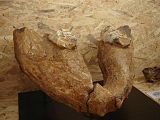Anancus
| Anancus Temporal range:
| |
|---|---|

| |
| A. arvernensis skeleton | |
| Scientific classification | |
| Kingdom: | Animalia |
| Phylum: | Chordata |
| Class: | Mammalia |
| Order: | Proboscidea |
| Superfamily: | Elephantoidea |
| Genus: | †Anancus Aymard, 1855 |
| Species | |
| |
Anancus is an extinct genus of elephantoid proboscidean native to Afro-Eurasia, that lived from the Tortonian stage of the late Miocene until the genus' extinction during the early Pleistocene, roughly from 8.5–2 million years ago.
Taxonomy[]

The type genus of the family, Anancus, was named by Auguste Aymard in 1855. It was traditionally allocated to Gomphotheriidae, but was later assigned to the family Elephantidae by McKenna and Bell (1997), Lambert and Shoshani (1998), Kalb and Froelich (1995), and Shoshani and Tassy (2005). Hautier et al. (2009) assigned the genus to the subfamily Anancinae within Gomphotheriidae.[1] Recently Anancus along with other tetralophodont gomphotheres have been removed from Gomphotheridae, and are now regarded as members of Elephantoidea instead.[2][3][4]
Description[]

Anancus stood around 3 metres (9.8 ft) tall, with a weight up to 5 tons, and closely resembled a modern elephant.[5] Aside from its somewhat shorter legs, Anancus was also different from modern elephants in that its tusks were much longer, up to 4 metres (13 ft) in length.[6] The tusks were possibly defense weapons, not unlike elephants of today.[7][8] The molars were not composed of lamellae like those of true elephants, but had cusps, like tapir and pig molars; Anancus appears to have lived in forests, eating from trees and shrubs and digging out tubers and roots in the forest floor, and it died out when these forests gave way to grasslands.[6] Stable carbon isotopes from Ethiopian Anancus tooth enamel 3–4 million years ago suggest that it grazed on C4 plants.[9]
Evolutionary history[]
The oldest known species of Anancus is A. perimensis, with fossils known from the Tortonian ~ 8.5 million years ago Siwalik Hills of Pakistan. Anancus entered Europe approximately 7.2 million years ago and around 7 million years ago dispersed into Africa. Anancus first appeared in China around 6 million years ago (A. sinensis). Anancus disappeared from Asia and Africa around the end of the Pliocene, approximately 2.6 million years ago. The European A. arvernensis was the last surviving species, becoming extinct during the Early Pleistocene, around 2 million years ago.[10]
Gallery[]
The jaw of Anancus, an extinct relative of the elephant
Jaw of Anancus arvernensis from Quaternary of Italy
Molar of Anancus arvernensis
References[]
- ^ Hautier, Lionel; Mackaye, Hassane Taisso; Lihoreau, Fabrice; Tassy, Pascal; Vignaud, Patrick; Brunet, Michel (March 2009). "New material of Anancus kenyensis (proboscidea, mammalia) from Toros-Menalla (Late Miocene, Chad): Contribution to the systematics of African anancines". Journal of African Earth Sciences. 53 (4–5): 171–176. Bibcode:2009JAfES..53..171H. doi:10.1016/j.jafrearsci.2009.01.003.
- ^ Shoshani, Jeheskel; Tassy, Pascal (January 2005). "Advances in proboscidean taxonomy & classification, anatomy & physiology, and ecology & behavior". Quaternary International. 126–128: 5–20. Bibcode:2005QuInt.126....5S. doi:10.1016/j.quaint.2004.04.011.
- ^ Shoshani, J.; Tassy, P. (1996). "Summary, conclusions, and a glimpse into the future". In Shoshani, Jeheskel; Tassy, Pascal (eds.). The Proboscidea: Evolution and Palaeoecology of Elephants and Their Relatives. Oxford University Press. pp. 335–348. ISBN 978-0-19-854652-8.
- ^ Mothé, Dimila; Ferretti, Marco P.; Avilla, Leonardo S. (12 January 2016). "The Dance of Tusks: Rediscovery of Lower Incisors in the Pan-American Proboscidean Cuvieronius hyodon Revises Incisor Evolution in Elephantimorpha". PLOS ONE. 11 (1): e0147009. Bibcode:2016PLoSO..1147009M. doi:10.1371/journal.pone.0147009. PMC 4710528. PMID 26756209.
- ^ http://donsmaps.com/mastodon.html Mastodons and related early elephants
- ^ a b Palmer, D., ed. (1999). The Marshall Illustrated Encyclopedia of Dinosaurs and Prehistoric Animals. London: Marshall Editions. p. 241. ISBN 1-84028-152-9.
- ^ The Free Dictionary: Tusks
- ^ Upali.ch Elephants in Zoo and Circus, Teeth, second dentition, tusks.
- ^ Levin, Naomi E.; Haile-Selassie, Yohannes; Frost, Stephen R.; Saylor, Beverly Z. (6 October 2015). "Dietary change among hominins and cercopithecids in Ethiopia during the early Pliocene". Proceedings of the National Academy of Sciences. 112 (40): 12304–12309. Bibcode:2015PNAS..11212304L. doi:10.1073/pnas.1424982112. PMC 4603467. PMID 26371308. S2CID 205272461.
- ^ Konidaris, George E.; Roussiakis, Socrates J. (2018-11-02). "The first record of Anancus (Mammalia, Proboscidea) in the late Miocene of Greece and reappraisal of the primitive anancines from Europe". Journal of Vertebrate Paleontology. 38 (6): e1534118. doi:10.1080/02724634.2018.1534118. ISSN 0272-4634.
- Benes, Josef (1979). Prehistoric Animals and Plants. Prague: Artua. p. 263.
- Elephantoidea
- Prehistoric placental genera
- Miocene proboscideans
- Pliocene proboscideans
- Pleistocene proboscideans
- Miocene genus first appearances
- Pleistocene genus extinctions
- Miocene mammals of Africa
- Pliocene mammals of Africa
- Pleistocene mammals of Africa
- Miocene mammals of Asia
- Pleistocene mammals of Asia
- Pliocene mammals of Asia
- Miocene mammals of Europe
- Pliocene mammals of Europe
- Pleistocene mammals of Europe
- Fossil taxa described in 1855





